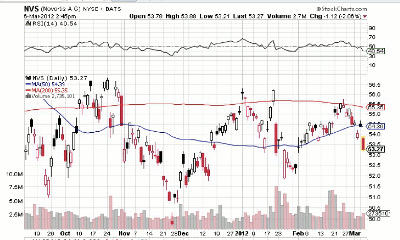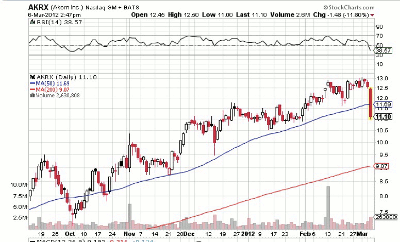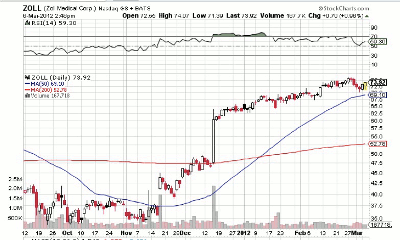Some health-care names show examples of price action that you’ll frequently see following a quarterly report. Taking some money off the table ahead of a report can be a prudent move to preserve capital, writes MoneyShow.com contributor Kate Stalter.
A couple of large-cap pharmaceuticals were getting beaten up in Tuesday’s market carnage. But one of those, Novartis (NVS), has been smacked around since last May. The other, Merck (MRK), has been sporting a much more gentle correction in recent weeks.
Though the stocks’ intraday declines were in the headlines Tuesday, neither company has been a top performer in the health care sub-sector of pharmaceuticals.
That’s not uncommon. Even when widely held Dow components, such as McDonald’s (MCD) or IBM (IBM), are rallying to new highs, small- and mid-caps within their sectors often sport better relative strength.
Within the S&P 500, health care is up 4.09% so far this year. In the small-cap S&P 600, that gain is 6.83%.
It’s not uncommon for smaller stocks to notch more powerful price gains than more mature names, which typically have lower betas.
One small-cap drug maker that I’ve tracked for several months is Akorn (AKRX). The maker of ophthalmological treatments and injectable drugs for hospital use reported its fourth quarter early Tuesday.
The company issued a disappointing yearly revenue forecast, sending shares 8% lower in above-average turnover.
Akorn’s action is typical of exhaustion after a strong run-up. To cite a more well-known current example of that phenomenon, Apple (AAPL) is retreating after three months in a row of accelerating price gains.
Akorn, which has a market cap of $1.1 billion, racked up gains each month from October through February. In five of those months, volume was higher than normal.
But Tuesday’s downside move in the stock also points up one of my key trading rules: Take some money off the table prior to the earnings report. Wall Street can punish a stock for anything in the report it perceives as negative, so there’s no need for retail investors to be caught unaware in the downdraft.
Of course, stocks can also rocket higher after an earnings report. Does that mean that a retail investor or trader who sells ahead of the announcement may forfeit some gains? Of course. But I prefer to protect my capital, rather than risk it all on the chance of a big gain.
So I’ll sell all or part of a position ahead of earnings. In the event of a gain, I can either repurchase shares if the stock remains in buy range after earnings, or watch for the next pullback for an alternate entry point—for example, at the next area of ten-week support, or a pattern of tight daily or weekly closes.
From another sector of health care, Zoll Medical (ZOLL), which makes cardiac resuscitation gear, is an example of a stock that sold off after earnings, but resumed its rally in subsequent sessions.
A few weeks before its report, the stock bolted 28.7% in monster volume on December 15, on news that Medicare would continue to pay for certain Zoll products. The stock trended higher in the following weeks.
By the time of the earnings report, some exhaustion had set in. The stock retreated 3.9% following the report, but reversed higher, logging gains in each of the next eight weeks.
Last week, Zoll pulled back from an all-time high of $76.22—where it hit resistance two sessions in a row. The stock found support at its ten-week moving average, and is now in a technical buy range, trading between the ten-week line and the previous high price.
At this juncture, with indices showing weakness, and a market downturn possibly in the works, I would avoid making aggressive buys. In the case of Zoll, an aggressive buy would mean entering before the stock surpasses the $76.22 mark. I’d prefer to be more conservative on this trade, and wait for the stock to prove itself with improved price action.
Counterintuitive? Yes, for value investors and traders who prefer to buy as a stock is declining. However, with risk management in the forefront as indices sell off in heavy volume, buying into strength is more prudent than buying on the dips.
In any type of market condition, my trend-following methodology will always have me entering long positions on price strength.
A “buy on the dip” opportunity could come in the case of ten-week support, such as what Zoll is showing at the moment. In a stronger market, that could offer a place to get in a bit earlier, rather than waiting for the price to approach or clear its prior high.
At the time of publication, Kate Stalter did not own positions in any of the stocks mentioned in this column.
Related Reading:
























